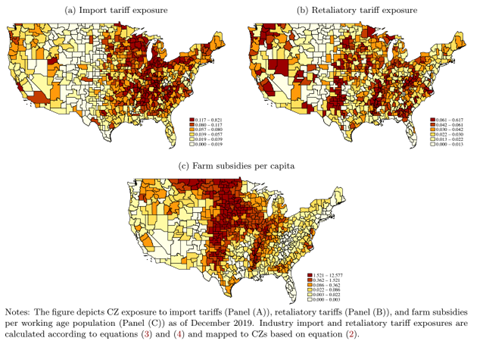Industry News
The 2018 Trade War Has Been an Employment Failure
TweetFeb. 12, 2024
By:
David G. Forgue
In 2018 and 2019 the United States and China began a series of moves and countermoves that made trade between them more difficult and more expensive. On the U.S. side these moves includes the imposition of Section 301 duties, Section 232 duties (although these were applied globally), and Section 201 duties on specific products from China. China and other trade partners imposed additional duties on a range of U.S. products in retaliation.
One stated rationale for these actions was to reinvigorate manufacturing in the United States, and the employment that was presumed to follow. However, a recently published study shows that in U.S. restrictions on imports were almost entirely offset by the impact of restrictions imposed by U.S. trade partners on U.S. exports. In other words, while the trade war has led to a reordering of sourcing priorities for many companies, it has not sparked a massive investment in employment to produce those goods in the United States.
The study’s authors posit three possible reasons for this. First, there may have been “trade diversion,” wherein importers found sourcing options that were neither Chinese nor U.S. domestic sources. There is a lot of evidence for this in the world today. Whether companies characterizing sourcing strategy as “ABC-anywhere but China,” the number of EAPA cases reflecting failed efforts to divert trade, or Mexico surpassing China as a source for import into the United States, it’s clear the sourcing world has been diverting trade from China (or attempting to).
Figure 1: © 2024 by David Autor, Anne Beck, David Dorn, and Gordon H. Hanson. All rights reserved.
The second possibility presented is that there has been a netting of increased employment in protected industries with declining employment in their unprotected customers. For instance, employment in the steel industry may have increased, but employment in industries utilizing steel may have declined as raw material prices increased. This may be true in some sectors, although it certainly is impacted by the reality in reason three.
The third possibility presented is one that is likely to bedevil policy makers for the foreseeable future if they focus on employment as an indicator of manufacturing success. The study says “[t]he lack of a clear positive employment response to the import tariffs could also result from firms’ ability to expand sales in the U.S. market without a commensurate increase in employment.” This observation likely will resonate with anyone who has been inside a manufacturing facility built in the United States in the last generation. There are generally lots of machines, a few people, and a lot of production. It evokes the old joke that the factory of the future will have two employees: a human and a dog. The human’s job will be to feed the dog, and the dog’s job will be to keep the human from touching any of the machines. This is not a formula for large expansions in employment.
Taken together, the three potential reasons presented by the authors make it unlikely that large increases in manufacturing employment as opposed to manufacturing will occur any time soon. To the extent that these policies are driven by the goal of increased employment, they are unlikely to be successful.
Interestingly, the study concludes that the trade war has been successful in the United States in one specific regard. Namely, it has been politically popular, and Republicans have received relative political benefit from it. Since the Biden Administration has largely left the restrictions in place and Republicans gain politically from the trade war, it is seems likely that the current reality of trade, particularly with China, is going to exist for the foreseeable future. Plan accordingly.
If you have questions regarding and trade restrictions and how they can be managed, whether AD/CVD, 201, 232, or 301 do not hesitate to contact any attorney at Barnes, Richardson & Colburn, LLP.

